A Case Study of Chemical Characteristics of Daytime and Nighttime Ambient Particles in Shanghai, China
Abstract
:1. Introduction
2. Experimental Section
2.1. Sample Collection

2.2. Carbonaceous Aerosol Measurement
2.3. Ion Analyses
2.4. Element Analyses
3. Results and Discussion
3.1. Characteristics of PM2.5 and TSP for Daytime and Nighttime
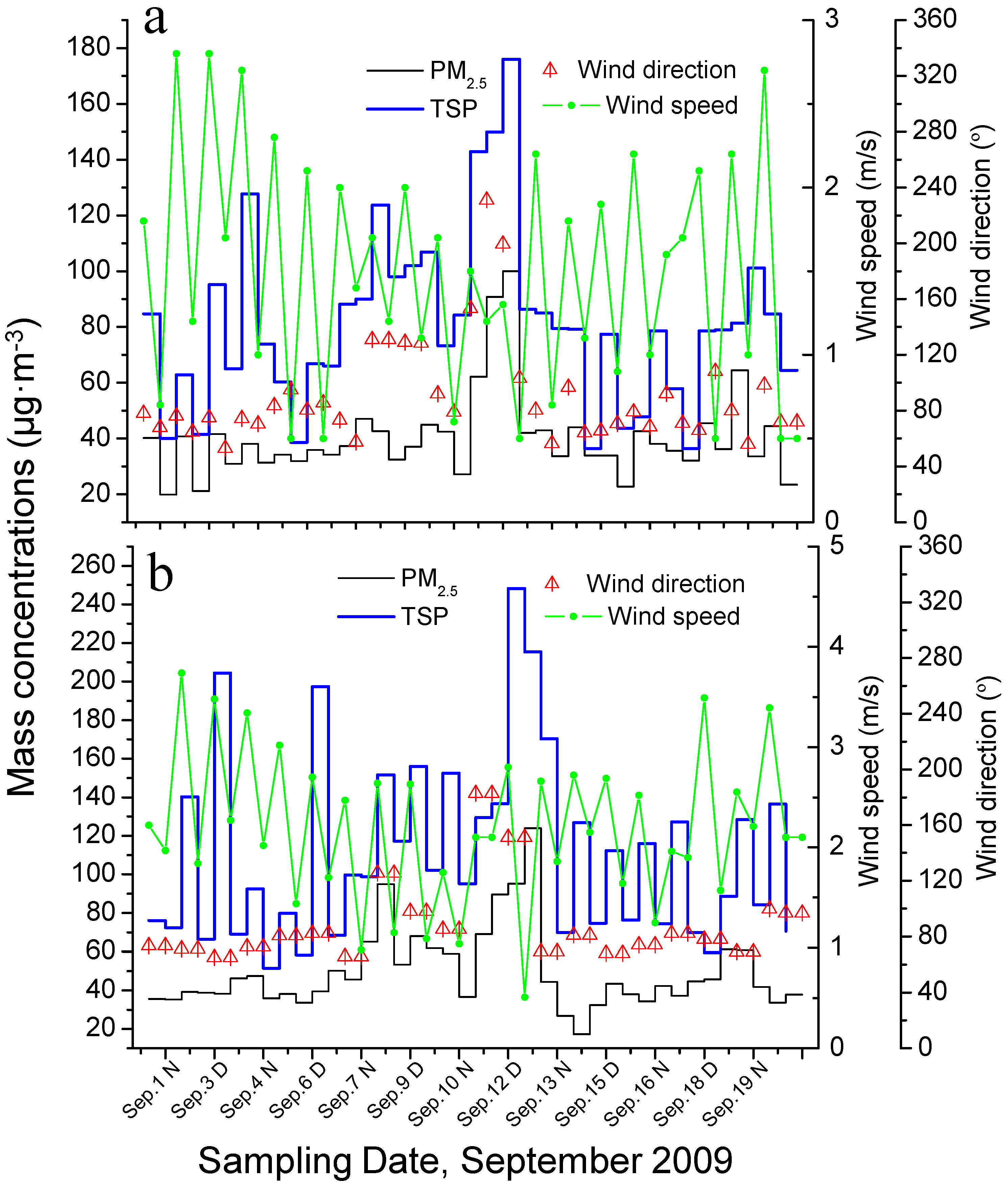
3.2. Variations of OC and EC
| Size | Carbon Fraction | Pudong Daytime | Pudong Nighttime | Jinshan Daytime | Jinshan Nighttime | ||||||||
|---|---|---|---|---|---|---|---|---|---|---|---|---|---|
| Ave. | Max. | Min. | Ave. | Max. | Min. | Ave. | Max. | Min. | Ave. | Max. | Min. | ||
| PM2.5 | OC | 8.0 | 14.6 | 3.9 | 5.7 | 10.8 | 2.8 | 14.5 | 32.7 | 7.7 | 19.1 | 45.8 | 6.7 |
| EC | 1.7 | 3.8 | 1.0 | 1.7 | 2.8 | 0.9 | 2.3 | 4.8 | 0.9 | 2.9 | 5.1 | 1.4 | |
| TSP | OC | 11.6 | 19.0 | 6.1 | 9.6 | 15.0 | 4.1 | 30.6 | 55.3 | 14.6 | 37.1 | 62 | 14 |
| EC | 2.7 | 4.9 | 1.5 | 2.5 | 4.2 | 1.2 | 3.9 | 7.9 | 1.5 | 4.4 | 8.2 | 2.2 | |
3.3. Variations of Water Soluble Ions
| Ions | Pudong Daytime | Pudong Nighttime | Jinshan Daytime | Jinshan Nighttime | ||||||||
|---|---|---|---|---|---|---|---|---|---|---|---|---|
| Ave. | Max. | Min. | Ave. | Max. | Min. | Ave. | Max. | Min. | Ave. | Max. | Min. | |
| Cl− | 4.36 | 8.05 | 3.14 | 3.85 | 6.45 | 2.80 | 4.22 | 5.88 | 3.11 | 4.87 | 6.94 | 3.94 |
| NO3- | 5.82 | 15.79 | 3.49 | 4.74 | 7.78 | 2.57 | 5.53 | 11.60 | n.a. | 6.97 | 16.24 | 2.86 |
| SO42- | 10.03 | 23.25 | 2.35 | 8.56 | 19.68 | 1.90 | 10.30 | 18.59 | 3.73 | 10.18 | 18.92 | 3.48 |
| Na+ | 0.69 | 2.35 | n.a. | 0.75 | 2.60 | n.a. | 0.53 | 1.40 | 0.15 | 0.63 | 0.90 | 0.22 |
| NH4+ | 0.85 | 1.91 | n.a. | 0.79 | 3.64 | n.a. | 0.49 | 1.80 | n.a. | 1.16 | 5.72 | n.a. |
| K+ | 0.52 | 1.04 | n.a. | 0.39 | 0.79 | n.a. | 0.38 | 1.33 | n.a. | 0.27 | 0.54 | n.a. |
| Mg2+ | 1.02 | 2.70 | n.a. | 1.33 | 3.72 | n.a. | 0.29 | 1.24 | n.a. | 0.29 | 1.04 | n.a. |
| Ca2+ | 2.40 | 7.45 | n.a. | 1.82 | 7.87 | n.a. | 6.08 | 18.14 | 0.13 | 5.67 | 13.92 | 2.04 |
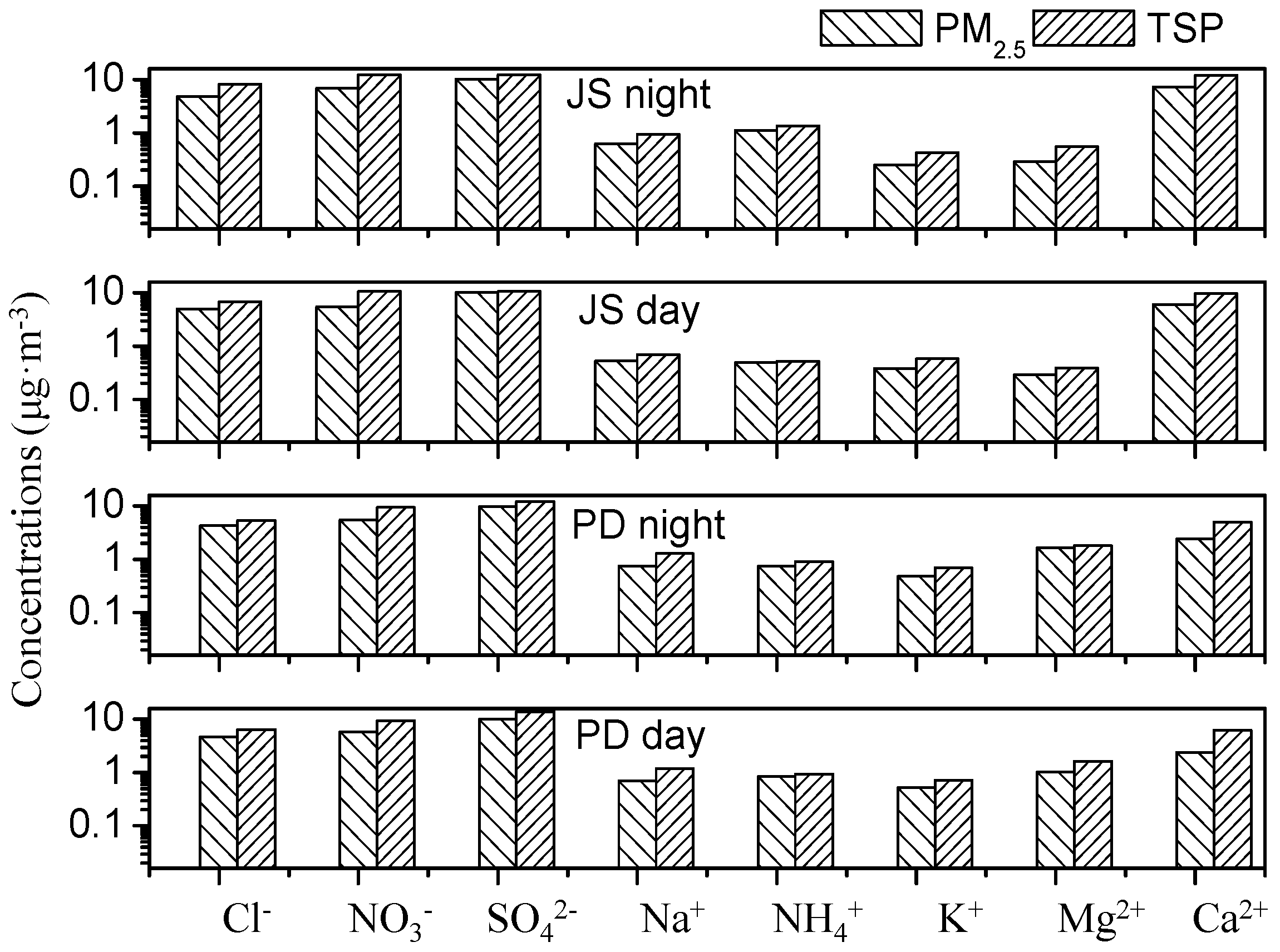
3.4. The Variations of Elemental Compositions
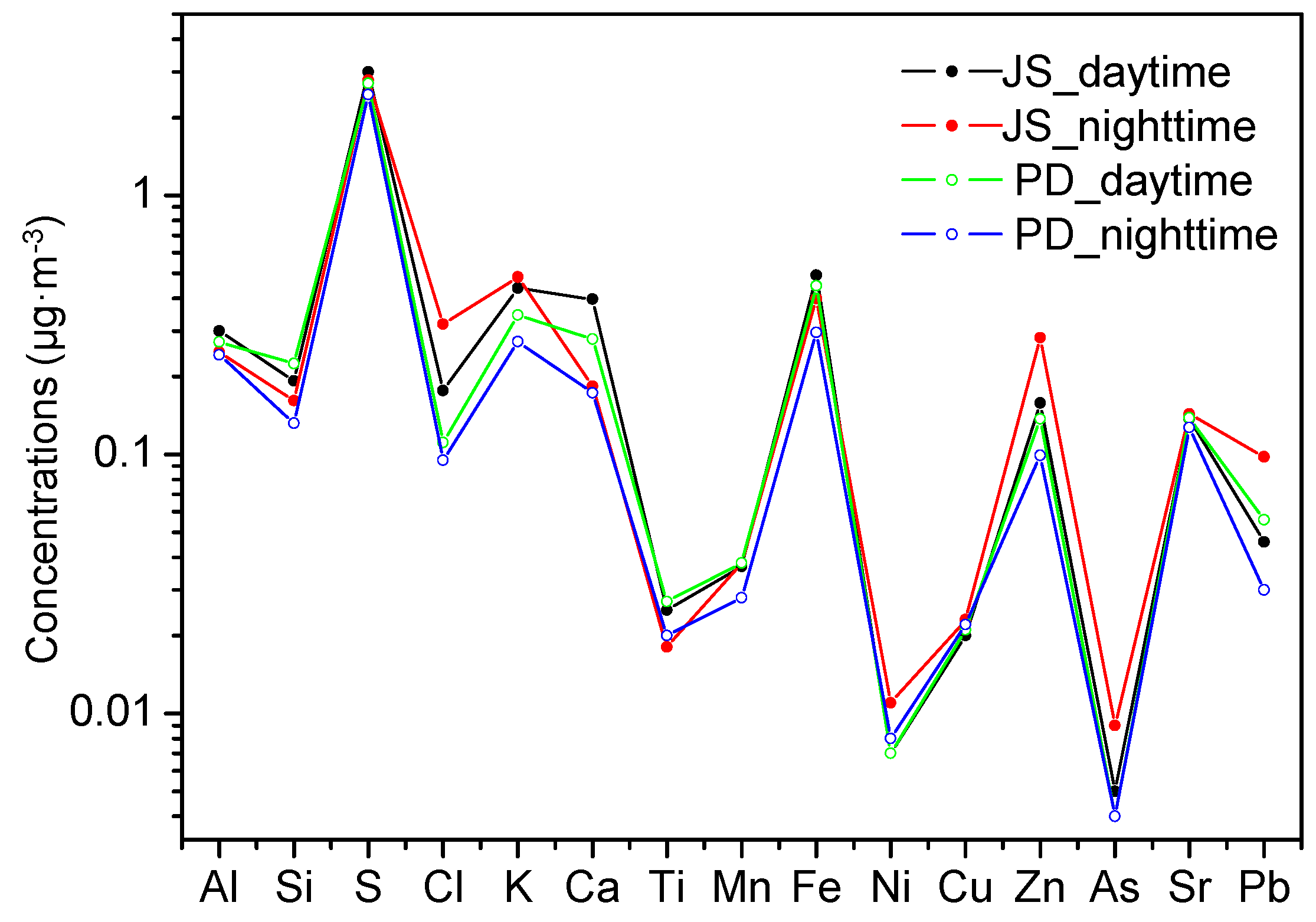
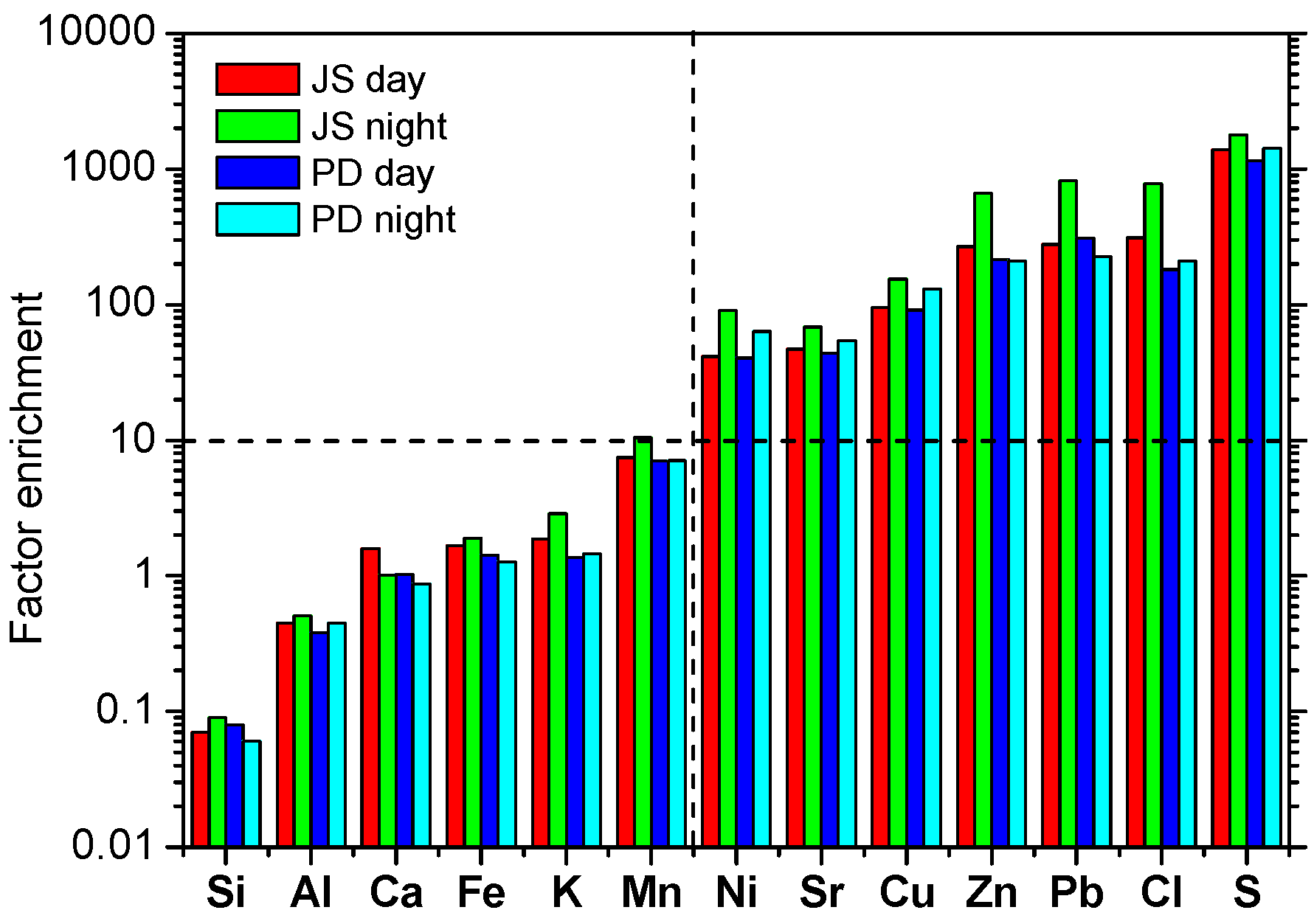
3.5. Indications of the Major Components Ratios
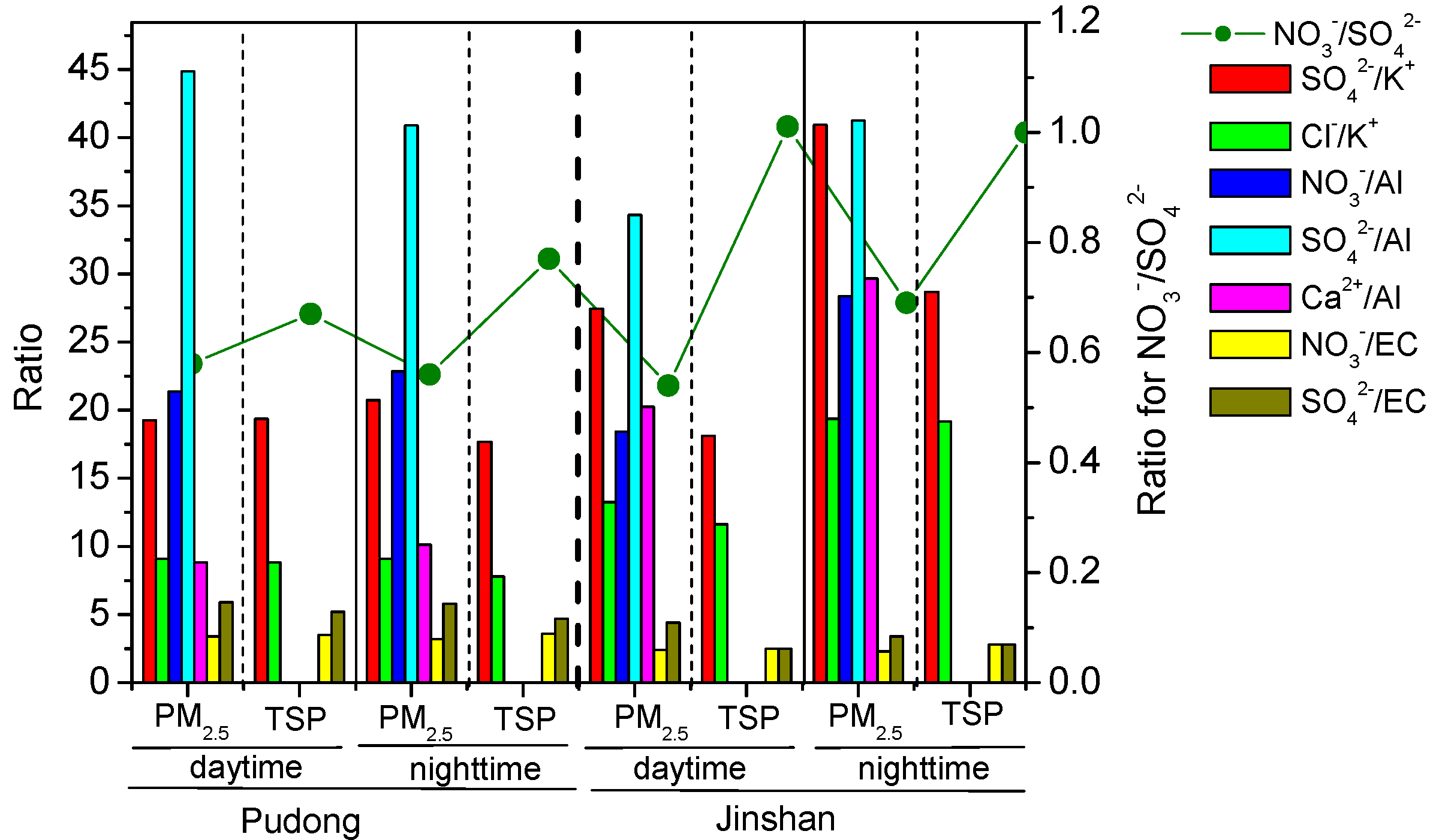
4. Conclusions
Acknowledgments
Author Contributions
Conflicts of Interest
References
- Charlson, R.J.; Scharwtz, S.E.; Hales, J.M.; Cess, R.D.; Coakley, J.A., Jr.; Hansen, J.E.; Hofman, D.J. Climate forcing by anthropogenic aerosols. Science 1992, 255, 423–430. [Google Scholar] [CrossRef] [PubMed]
- Ye, B.M.; Ji, X.L.; Yang, H.Z.; Yao, X.H.; Chan, C.K.; Cadle, S.H.; Chan, T.; Mulaw, P.A. Concentration and chemical composition of PM2.5 in Shanghai for a 1-year period. Atmos. Environ. 2003, 37, 499–510. [Google Scholar] [CrossRef]
- Zhang, M.G.; Han, Z.W.; Zhu, L.Y. Simulation of atmospheric aerosols in East Asia using modeling system RAMS-CMAQ: model evaluation. China Particuology 2007, 5, 321–327. [Google Scholar] [CrossRef]
- Zhang, R.J.; Ho, K.F.; Cao, J.J.; Han, Z.W.; Zhang, M.G.; Cheng, Y.; Lee, S.C. Organic carbon and elemental carbon associated with PM10 in Beijing during spring time. J. Hazard. Mater. 2009, 172, 970–977. [Google Scholar] [CrossRef] [PubMed]
- Cao, J.J.; Xu, H.M.; Xu, Q.; Chen, B.H.; Kan, H.D. Fine particulate matter constituents and cardiopulmonary mortality in a heavily polluted Chinese city. Environ. Health Persp. 2012, 120, 373–378. [Google Scholar] [CrossRef] [PubMed]
- Jacobson, M.C.; Hansson, H.C.; Noone, K.J.; Charlson, R.J. Organic atmospheric aerosols: Review and state of the science. Rev. Geophys. 2000, 38, 267–294. [Google Scholar] [CrossRef]
- Cao, J.J.; Lee, S.C.; Ho, K.F.; Zou, S.C.; Fung, K.; Li, Y.; Watson, J.G.; Chow, J.C. Spatial and seasonal variations of atmospheric organic carbon and elemental carbon in Pearl River Delta Region, China. Atmos. Environ. 2004, 38, 4447–4456. [Google Scholar] [CrossRef]
- Cao, J.J.; Wu, F.; Chow, J.C.; Lee, S.C.; Li, Y.; Chen, S.W.; An, Z.S.; Fung, K.K.; Watson, J.G.; Zhu, C.S.; Liu, S.X. Characterization and source apportionment of atmospheric organic and elemental carbon during fall and winter of 2003 in Xi’an, China. Atmos. Chem. Phys. 2005, 5, 3127–3137. [Google Scholar] [CrossRef]
- Shen, Z.X.; Cao, J.J.; Arimoto, R.; Zhang, R.J.; Jie, D.M.; Liu, S.X.; Zhu, C.S. Chemical composition and source characterization of spring aerosol over Horqinsandland in northeastern China. J. Geophys. Res. 2007, 112, D14315. [Google Scholar] [CrossRef]
- Shen, Z.X.; Cao, J.J.; Tong, Z.; Liu, S.X.; Reddy, L.S.S.; Han, Y.M.; Zhang, T.; Zhou, J. Chemical characteristics of submicron particles in winter in Xi’an. Aerosol Air Qual. Res. 2009, 9, 80–93. [Google Scholar] [CrossRef]
- Yang, F.; He, K.; Ye, B.; Chen, X.; Cha, L.; Cadle, S.H.; Chan, T.; Mulawa, P.A. One-year record of organic and elemental carbon in fine particles in downtown Beijing and Shanghai. Atmos. Chem. Phys. 2005, 5, 1449–1457. [Google Scholar] [CrossRef]
- Feng, Y.L.; Chen, Y.J.; Guo, H.; Zhi, G.R.; Xiong, S.C.; Li, J.; Sheng, G.Y.; Fu, J.M. Characteristics of organic and elemental carbon in PM2.5 samples in Shanghai, China. Atmos. Res. 2009, 92, 434–442. [Google Scholar]
- Chow, J.C.; Yu, J.Z.; Watson, J.G.; Ho, S.S.H.; Bohannan, T.L.; Hays, M.D.; Fung, K.K. The application of thermal methods for determining chemical composition of carbonaceous aerosols: A review. J. Environ. Sci. Health 2007, 42, 1521–1541. [Google Scholar] [CrossRef] [PubMed]
- Han, Y.M.; Cao, J.J.; Chow, J.C.; Watson, J.G.; Fung, K.K.; Jin, Z.D.; Liu, S.X.; An, Z.S. Evaluation of the thermal/optical reflectance method for discrimination between soot- and char-EC. Chemosphere 2007, 69, 569–574. [Google Scholar] [CrossRef] [PubMed]
- Han, Y.M.; Lee, S.C.; Cao, J.J.; Ho, K.F.; An, Z.S. Spatial distribution and seasonal variation of char-EC and soot-EC in the atmosphere over China. Atmos. Environ. 2009, 43, 6066–6073. [Google Scholar] [CrossRef]
- Chow, J.C.; Watson, J.G.; Robles, J.; Wang, X.; Chen, L.W.; Trimble, D.L.; Steven, D.K.; Richard, J.T.; Kochy, K.F. Quality assurance and quality control for thermal/optical analysis of aerosol samples for organic and elemental carbon. Anal. Bioanal. Chem. 2011, 401, 3141–3152. [Google Scholar] [CrossRef] [PubMed]
- Brouwer, P. Theory of XRF: Getting Acquainted with the Principles; PANanalytical: Almelo, The Netherlands, 2003; pp. 50–58. [Google Scholar]
- Shan, W.P.; Lu, H.X.; Huo, S.Y.; Huang, Z.X.; You, L.N. Analysis of a high PM10 episode observed at a coastal site nearby Shanghai, China. Environ. Monit. Assess. 2010, 163, 337–345. [Google Scholar] [CrossRef] [PubMed]
- Contini, D.; Belosi, F.; Gambaro, A.; Cesari, D.; Stortini, A.M.; Bove, M.C. Comparison of PM10 concentrations and metal content in three different sites of the Venice Lagoon: An analysis of possible aerosol sources. J. Environ. Sci. 2012, 24, 1954–1965. [Google Scholar] [CrossRef]
- Wilson, J.G.; Kingham, S.; Pearce, J.; Sturman, A.P. A review of intraurban variations in particulate air pollution: Implications for epidemiological research. Atmos. Environ. 2005, 39, 6444–6462. [Google Scholar] [CrossRef]
- He, K.; Yang, F.; Ma, Y.; Zhang, Q.; Yao, X.; Chan, C.K.; Cadle, S.; Chan, T.; Mulawa, P. The characteristics of PM2.5 in Beijing, China. Atmos. Environ. 2001, 35, 4959–4970. [Google Scholar] [CrossRef]
- Cao, J.J.; Lee, S.C.; Chow, J.C.; Watson, J.G.; Ho, K.F.; Zhang, R.J.; Jin, Z.D.; Shen, Z.X.; Chen, G.C.; Kang, Y.M.; et al. Spatial and seasonal distributions of carbonaceous aerosols over China. J. Geophys. Res. 2007, 112, D22S11. [Google Scholar] [CrossRef]
- Shen, Z.X.; Cao, J.J.; Liu, S.X.; Zhu, C.S.; Wang, X.; Zhang, T.; Xu, H.M.; Hu, T.F. Chemical composition of PM10 and PM2.5 collected at ground level and 100 meters during a strong wintertime pollution episode in Xi’an, China. J. Air Waste Manag. Assoc. 2011, 61, 1150–1159. [Google Scholar]
- Tao, J.; Shen, Z.X.; Zhu, C.S.; Yue, J.H.; Cao, J.J.; Liu, S.X.; Zhu, L.H.; Zhang, R.J. Seasonal variations and chemical characteristics of sub-micrometer particles (PM1) in Guangzhou, China. Atmos. Res. 2012, 118, 222–231. [Google Scholar] [CrossRef]
- Cao, J.J.; Lee, S.C.; Ho, K.F.; Zhang, X.Y.; Zou, S.C.; Fung, K.K.; Chow, J.C.; Watson, J.G. Characteristics of carbonaceous aerosol in Pear River Delta Region, China during 2001 winter period. Atmos. Environ. 2003, 37, 1451–1460. [Google Scholar] [CrossRef]
- Cao, J.J.; Zhu, C.S.; Tie, X.X.; Geng, F.H.; Xu, H.M.; Ho, S.S.H.; Wang, G.H.; Han, Y.M.; Ho, K.F. Characteristics and sources of carbonaceous aerosols from Shanghai, China. Atmos. Chem. Phys. 2013, 13, 803–817. [Google Scholar] [CrossRef]
- Duan, F.K.; He, K.B.; Ma, Y.L.; Yang, F.M.; Yu, X.C.; Cadle, S.H.; Chan, T.; Mulawa, P.A. Concentration and chemical characteristics of PM2.5 in Beijing, China: 2001–2002. Sci. Total Environ. 2006, 355, 264–275. [Google Scholar] [CrossRef] [PubMed]
- Contini, D.; Cesari, D.; Genga, A.; Siciliano, M.; Ielpo, P.; Guascito, M.R.; Conte, M. Source apportionment of size-segregated atmospheric particles based on the major water-soluble components in Lecce (Italy). Sci. Total Environ. 2014, 472, 248–261. [Google Scholar] [CrossRef] [PubMed]
- Taylor, S.R.; McLennan, S.M. The Continental Crust: Its Composition and Evolution; Blackwell Scientific Publications: Oxford, UK, 1985. [Google Scholar]
- Cesari, D.; Contini, D.; Genga, A.; Siciliano, M.; Elefante, C.; Baglivi, F.; Daniele, L. Analysis of raw soils and their re-suspended PM10 fractions: Characterisation of source profiles and enrichment factors. Appl. Geochem. 2012, 27, 1238–1246. [Google Scholar] [CrossRef]
- Arimoto, R.; Duce, R.A.; Savoie, D.L.; Prospero, J.M.; Talbot, R.; Cullen, J.D.; Tomza, U.; Lewis, N.F.; Ray, B.J. Relationships among aerosol constituents from Asia and the North Pacific during PEM-West A. J. Geophys. Res. 1996, 101, 2011–2023. [Google Scholar] [CrossRef]
- Ramana, M.V.; Ramanathan, V.; Feng, Y.; Yoon, S.C.; Kim, S.W.; Carmichael, G.R.; Schauer, J.J. Warming influenced by the ratio of black carbon to sulphate and the black-carbon source. Nat. Geosci. 2010, 3, 542–545. [Google Scholar] [CrossRef]
- Wang, Y.; Zhuang, G.; Sun, Y.; An, Z. The variation of characteristics and formation mechanisms of aerosols in dust, haze, and clear days in Beijing. Atmos. Environ. 2006, 40, 6579–6591. [Google Scholar] [CrossRef]
© 2015 by the authors; licensee MDPI, Basel, Switzerland. This article is an open access article distributed under the terms and conditions of the Creative Commons Attribution license (http://creativecommons.org/licenses/by/4.0/).
Share and Cite
Zhu, C.; Cao, J.; Zhou, J.; Liu, S.; Dai, W.; Zhang, T.; Zhao, Z.; Shen, Z.; Li, H.; Wang, P. A Case Study of Chemical Characteristics of Daytime and Nighttime Ambient Particles in Shanghai, China. Atmosphere 2015, 6, 1141-1153. https://doi.org/10.3390/atmos6081141
Zhu C, Cao J, Zhou J, Liu S, Dai W, Zhang T, Zhao Z, Shen Z, Li H, Wang P. A Case Study of Chemical Characteristics of Daytime and Nighttime Ambient Particles in Shanghai, China. Atmosphere. 2015; 6(8):1141-1153. https://doi.org/10.3390/atmos6081141
Chicago/Turabian StyleZhu, Chongshu, Junji Cao, Jiamao Zhou, Suixin Liu, Wenting Dai, Ting Zhang, Zhuzi Zhao, Zhenxing Shen, Hua Li, and Ping Wang. 2015. "A Case Study of Chemical Characteristics of Daytime and Nighttime Ambient Particles in Shanghai, China" Atmosphere 6, no. 8: 1141-1153. https://doi.org/10.3390/atmos6081141
APA StyleZhu, C., Cao, J., Zhou, J., Liu, S., Dai, W., Zhang, T., Zhao, Z., Shen, Z., Li, H., & Wang, P. (2015). A Case Study of Chemical Characteristics of Daytime and Nighttime Ambient Particles in Shanghai, China. Atmosphere, 6(8), 1141-1153. https://doi.org/10.3390/atmos6081141







